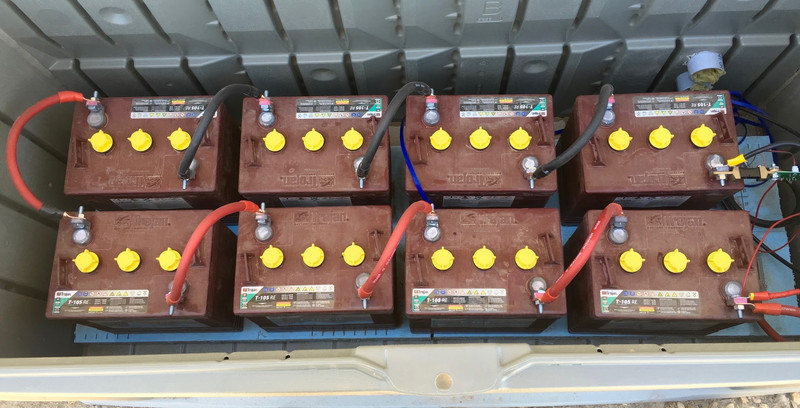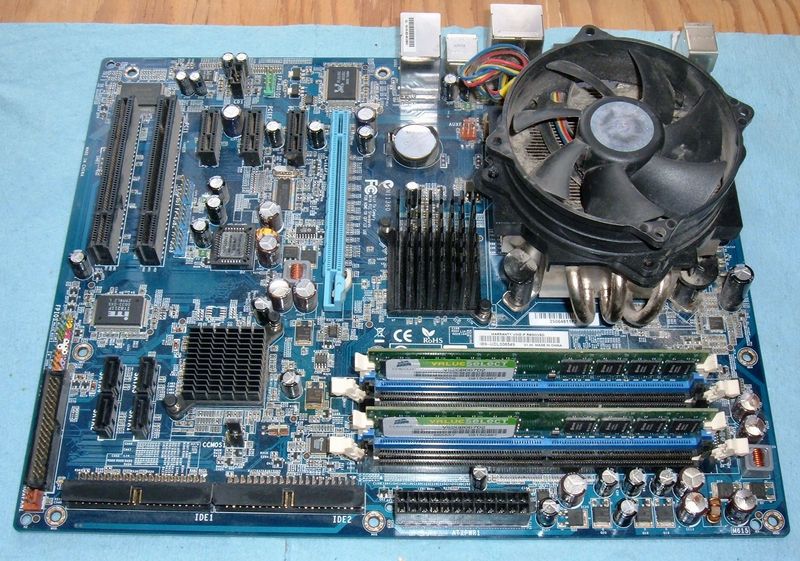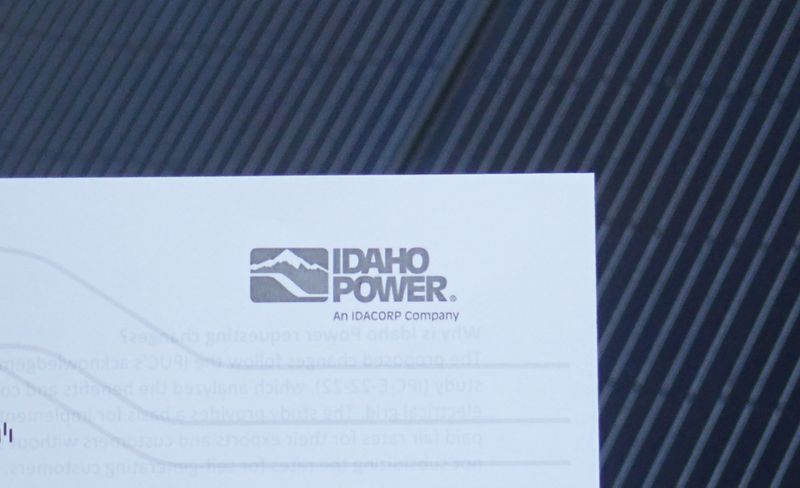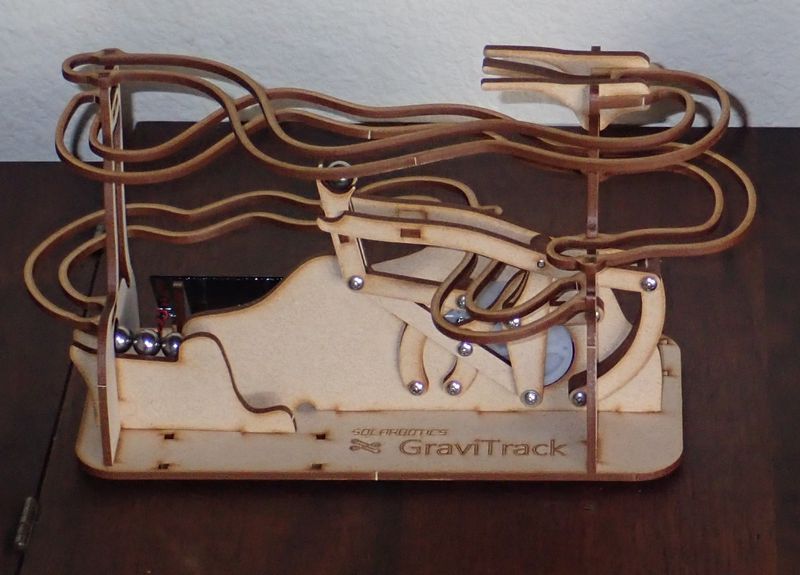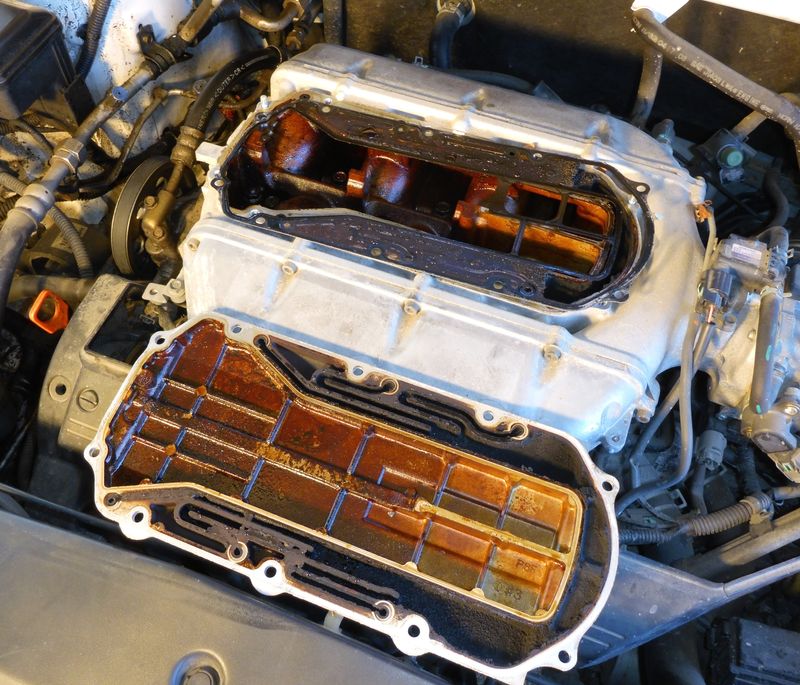People are regularly surprised that my solar powered office is driven by a moderately sized bank of lead acid batteries instead of a fancy modern lithium bank. I mean, I do work on lithium batteries regularly, and I could certainly build myself a large lithium bank at fairly minimal cost (compared to purchasing one, if I were willing to do that much spot welding). But, in a deck box behind my office, I have a boring set of 8 Trojan T-105RE batteries in a 48V/225Ah (10.8kWh) bank. Why?

Quite a few reasons - which I’m about to dive into! Read on!
Off Grid Power
Before diving too far into the types of batteries used off grid, I’d like to define what I mean by off grid use. Some of the characteristics I mention are of great value off grid, and of far less value for a grid tied system.
By off grid, I mean a battery system that is the primary energy store for a structure without a power grid connection. So, a home without the power grid, a business without the power grid, a little solar powered shed without the power grid, etc.
In general, this sort of system is subject to daily cycles. This means that the battery is charged and discharged (ideally both, but sometimes only discharged) every single day. Or very close to it. The system never has a chance to sit and rest, because it’s always under some sort of load (charge or discharge). And, generally, it means there’s someone around who can pay attention to it.
An alternative I’ll mention occasionally is “cabin use” or “RV use.” This refers to a system that is used sometimes (often on weekends or for a week at a time), but isn’t used for full time power. For a cabin in the mountains, the system may get used a few days, and then will have a week or more (unattended) to charge. For an RV, the same applies. If you’re full timing in an RV, you have a power use much closer to a standard off grid system, so pay attention to those bits.
Lead Acid Batteries
As much as it stuns a lot of people to learn this, the vast majority of off grid power systems out there today use lead acid batteries. Most of them use flooded lead acid (it sloshes when you move it), though there are certainly some systems using sealed batteries (typically AGM). They work - quite well, in fact. And they have some characteristics that are very well suited to an off grid power system, especially with some of the new developments.
I’ve written a post about keeping lead acid batteries alive in an off grid power system, which you may find very helpful if you’re using them, or if you’re interested in their quirks and how to keep them alive.
In general, lead acid batteries really like being fully charged, and the system should be designed around keeping them as fully charged as possible, as much as possible. The various lead carbon blends reduce the requirements for this somewhat, but it’s still helpful to charge them fully and regularly - regardless of the type.
Types of Lead Acid Batteries
There are a few different axis you can categorize lead acid batteries on. Some are great for off grid use, some are reasonably terrible for off grid use. It’s important to understand this, because using the wrong type of battery for the use case will generally work incredibly poorly, and lead to a uselessly short battery life (and will make off grid power even more expensive than it already is).
Common to all lead acid variants is that they really, really like to be fully charged - regularly. If lead acid isn’t fully charged quite often, they suffer (to varying degrees) from sulfation. In the context of battery longevity, sulfation refers to the hard sulfation that builds up on plates, blocking active area and preventing the battery from delivering rated power or capacity. If you’re interested in more details on lead acid, I’ll refer you to my detailed post on lead acid.
One problem for off grid use with lead acid is that they don’t charge instantly. To properly charge lead acid, pump current in until the voltage is at a particular temperature compensated value, then hold it there until the charge current drops off. A “quick” charge cycle for my bank is 5-6 hours from sun up until I drop to float, and that can be a good bit longer (or even all day long) if I don’t get as much sun.
Flooded Lead Acid (FLA)
The most common type of lead acid battery out there, especially for off grid, is flooded lead acid. This has plates of lead and lead dioxide dunked in a liquid sulfuric acid (“battery acid”) electrolyte. If it sloshes, it’s flooded lead acid. They’re very robust and hard to damage, but they require good ventilation as they offgas hydrogen and oxygen during charging, and then watering to make up that hydrogen and oxygen. The oxygen isn’t a problem, but you don’t want hydrogen building up in enclosed spaces. It’ll ignite if you look at it wrong (seriously, the ignition energy for hydrogen is frighteningly low), and hydrogen explosions are no fun.

Flooded lead acid is best for a daily cycled system that can get regular maintenance. They need watering every few months, and if they’re left fully discharged, they can freeze in the cold (as well as badly sulfating the plates up). However, they’re incredibly tolerant of being moderately overcharged (useful as the string gets older to help keep things balanced), and you can get the “ground truth” about the health of each cell by measuring the specific gravity. There’s no need to rely on voltages and guesses to figure out battery health.
Absorbed Glass Mat (AGM)
The other common type of lead acid battery (and certainly more common in some uses) is Absorbed Glass Mat. This type still has the lead plates, but instead of liquid electrolyte sloshing around, the spaces between the plates are filled with a weave of glass fibers, and the electrolyte is soaked into these. The weave isn’t fully saturated, though, so the acid remains fixed in place. There’s no liquid to slosh around, which means these batteries can be mounted in almost any orientation, and they don’t (typically) release gasses during charging. The cells are designed such that the hydrogen and oxygen can recombine in the cell if the charging proceeds at normal rates. There are vents that will release an overpressure, but they shouldn’t trigger during normal operation.
AGM has some advantages over flooded lead acid for certain uses. They tend to have a lower internal resistance, which makes for better power delivery and faster charging. They’re maintenance free (“maintenance impossible”), which can be nice if they’re sitting unused for part of the year. They also do somewhat better in cold temperatures, but it’s still a bad idea to let them freeze. And, if you have varying battery angles (say, a sailboat), they won’t spill.
However, they’re more expensive than flooded, typically have a shorter service life (compared to comparably priced flooded), and since you can’t measure the specific gravity (only voltage), it’s harder to make sure that they’re being fully charged.
Gel/”Lead Crystal”/”Lead Silicon”
The final variant of lead acid is the gelled electrolyte type. This involves some additive in the electrolyte that turns it into a stiff jelly instead of a liquid. It’s similar to AGM in many ways (orientation independence, maintenance free/impossible), but it’s a lot toucher about charging voltages, and it doesn’t work very well in the cold. They’re somewhat more than a “gimmick” battery, but an awful lot of the marketing makes them seem like a gimmick.
They have no business in an off grid power system of any sort, and if you run across some quirky sounding lead based battery with slick marketing, it’s probably a gel battery - and you should avoid it.
Lead Carbon
Lead carbon isn’t actually a type of lead acid, but it’s something you’ll see in the marketing. It refers to blends of lead and carbon, usually on the negative plate, that help prevent hard sulfation from building up. It’s a good thing for an off grid power system, because it means that if the battery doesn’t get fully charged during some of the winter months, it shouldn’t cause the same sort of capacity loss and damage that you might see without the carbon.
The problem with this sort of technology is that it takes an awful lot of years, in real world conditions, to find out how good it is. The shorter term tests are very promising, but it’s not until people wear out batteries in the real world that we see how good things really are.
For an off grid system, I think the various carbon additives in the plates are worth the slight extra cost to experiment with, though.
Lithium Ion Batteries
Moving on from the ancient lead acid technology, the next battery technology I’m covering is lithium ion.
I rebuild lithium ion packs for people, and I’m quite familiar with the characteristics of lithium batteries. They’re absolutely an established technology, and by traditional battery terms, they are impressive. The energy density (kWh) is awesome, the power density (W) is awesome, and the cycle life ranges from “meh” to “wowzers,” depending heavily on the particular chemistry involved and how they’re treated. The lithium ion cells people are most familiar with are 18650s - 18mm in diameter, 65mm long. And a cylinder.

There is an incredible amount of research and investment going into the various lithium ion chemistries, and they’re quite exciting for many applications. The modern wave of electric cars wouldn’t be possible without them, cell phones rely on them, and pretty much any long lasting device uses lithium ion cells of one chemistry or another. They also charge quite rapidly and don’t need any sort of “absorb” cycle during charge. Just pump current into them and don’t exceed the fully charged voltage (you’ll get a tapering of charge current, but it takes far less time than lead acid to fully charge).
We’re seeing more and more lithium ion for stationary power storage, but they’re still not particularly common in off grid systems - and, I’ll argue, most of the variants aren’t a great fit for off grid power storage for a few reasons.
Characteristics of Lithium Ion
Lithium ion batteries are amazing for portable energy storage - cell phones, laptops, and electric cars wouldn’t be anywhere near where they are today without lithium ion batteries. They store a ton of energy, they can release it incredibly quickly, and they can maintain a reasonable cycle life while doing this.
But, all that said, they have a few characteristics that make them a bit annoying to use in an off grid system.
The first is that they’re most stressed when fully charged and when fully empty (or deeply discharged - you really shouldn’t let a normal lithium chemistry below about 2.5V/cell, and there’s no good reason to be down even that low). Sitting fully charged (4.2V/cell or 4.35V/cell, depending on the chemistry, though some go even higher) is really hard on lithium cells - and an off grid power system is likely to be doing this for a large part of the year if it’s been designed for year round use.
The second is that lithium ion cells require good thermal management. Getting them hot really hurts cycle life (which is true of lead acid as well, but lead acid has an awful lot more thermal mass to prevent them from getting hot) - but being hot and fully charged, as one might find in the summer with long, hot days of sun, just slaughters them. In addition, they can’t be safely charged if they’re below about 45F (7C). You get lithium plating and that’s permanent capacity loss.
So, what this means for off grid use is that you really either need to have the batteries inside where they’re thermally regulated, or you need a separate heating/cooling system for them that keeps them in a safe temperature range. This is part of why some of the packs out there have cooling loops.
Thermal Runaway and Venting
Lithium chemistries also have a particularly nasty failure mode called “thermal runaway.” If they get too hot for whatever reason, they start degrading internally at an ever-increasing rate - which releases energy. Once they get hot enough, they start gassing their electrolyte and melting their internal bits, which gets really exciting, really fast. The electrolyte gasses are typically flammable, and it’s not at all uncommon to have molten bits of metal coming out the vent as well - so you get a nice little torch. This failure mode releases enough energy to propagate to other nearby cells, and YouTube has many videos of this happening (either intentionally or by mistake).
There’s a great paper from 2014 comparing the failure modes of a few different chemistries, and the takeaway should be that you shouldn’t use LiCoO2 anywhere. LiFePO4 is far better, and the other more recent lithium chemistries sit somewhere in between.
The takeaway here should be that you really want to use LiFePO4 if you’re going with non thermally managed lithium. Alternately, a pack that does proper thermal management and can prevent runaway. Yes, I know the “DIY Powerwall” folks do things differently. No, I don’t think that’s a good idea. Yes, I think they’re building hazardous fireballs waiting for a place to happen. Don’t build one of those monstrosities out of junk cells if you plan to keep it within fire spread range of where you sleep.
Slick All-in-One Lithium Packs
You know, “Powerwall” type devices. If you have the money for one, have the tolerance for the unknown unknowns of one, and can find someone to install one for you in an off grid setup, have a ball. I don’t treat them as a particularly useful option because they’re almost always seriously short on documentation, and are not (near as I can tell) particularly configurable. They’re a black box, and I’m not really OK with those in an off grid system I have to maintain myself. If you can find one with open documentation such that one can interface with it externally (or, ideally, that drives the voltages like a lead acid pack so you don’t even need to talk to it if you don’t want), let me know. Until then, I stand by my view that they’re likely to be more trouble than they’re worth, off grid.
If you’re going to insist, in the comments, that they’re the future and I should promote them, please answer one question first: How much energy does a Powerwall consume in the winter to stay warm? Or in the summer to stay cool? That type of thing matters for off grid use.
Nickel Iron (“Edison Cells”)
Finally, I want to touch on the nickel iron chemistry. On paper, it looks amazing. They last nearly forever, don’t care if you overcharge them, aren’t hurt by sitting drained, and are the sort of robust battery that means you can probably buy them for life.
Which… is mostly true. The problem is that they’re actually quite the royal pain to actually live with. There are a few people over on SolarPanelTalk who have the NiFe cells, and they try, ever so hard, to like them - but they mostly find them annoying.
The major downsides of NiFe are that they’re insanely inefficient (in terms of round trip energy), they absolutely guzzle water, they’re quite loud when charging, and they suffer (fairly badly) from carbonate poisoning as they absorb carbon from the air.
“Round trip efficiency” means “Power out versus power in” - in watt-hours, not amp-hours. NiFe cells have a much higher charging voltage than discharge voltage, percentage-wise, and they’re pretty good at gassing during charge (which isn’t “useful” from a charge perspective). If you get about 60%, you’re doing well. This means that you need more solar, or more generator use, to get a certain amount of energy out of the system.
The aggressive gassing during charge means that the battery bank is insanely loud (as in, “You should have hearing protection to work around it during charging”). This also means that a good sized bank will go through many gallons of distilled water a month (you may wish to consider running your own distiller if you have a NiFe bank). A good sized lead acid bank will go through a few gallons a year.
On top of that, while you can replace the electrolyte every decade or so (and have to), there’s no particularly good place to dump a lot of hazmat (potassium hydroxide and lithium hydroxide).
Plus, the up front costs are staggering.
It’s useful in some situations (I might use them for a mountaintop power outpost if I could find an automatic watering system I trusted), but it’s just not a good general purpose off grid solution for most people, in most systems.
Off Grid Seasons
Before diving into what I think the best battery choice is, I need to discuss the four seasons of off grid power and how the system will typically run - because this directly feeds into why I make the suggestions I do.
Solar Summer
Most people assume that summer is the best for an off grid power system due to the long, sunny days. It’s actually a bit harder than it seems, at least if you have any sort of mechanical refrigeration (“Air conditioning”) powered from solar.
Yes, the days are long, but the days are also very hot! As solar panels heat up, they produce less power (at least if you have a MPPT charge controller, which you should). My panels lose output as they heat up at the rate of 0.41%/C - so on a hot day (40C), with the panels baking in the sun (say, 60C), they produce 20% less power than on a cool, breezy day with the panels at 10C. You notice the difference. Plus, summer time tends to have less rain (at least in a lot of the country), so the panels are dirty. And, worse, in the west, you get wildfires. That cruds up the sky quite badly, and the smoke coats the panels. By the fall, my panels are absolutely disgusting, and I can tell the difference in power output. I’d say they are easily 25-30% down on power by the first rains of fall.
Solar Spring/Fall
Spring and fall are, at least for me, the easiest times of year. The days are shorter, but the skies are clear, the panels are cool, and I need far less in the way of cooling. I have plenty of power to ride through the night (admittedly, my night use is fairly low), and there’s a ton of surplus to throw at diversion loads. Plus, we get rain often enough that my panels are clean. I don’t clean my panels other than letting them sit outside in the rain, so this makes a difference. The jump in production from the rain of fall is huge.
For the sunny three seasons (spring, summer, and fall), your battery bank is likely to be fully charged, almost every day. This means that the battery bank will be spending a lot of time full - which, if you recall, is something lead acid really likes doing!
Solar Winter
Sucks. You have a backup generator and charger, right?

Winter is the worst time for solar, obviously, but I’d thought I could overpanel my way through it. Nope! We get inversions in the winter, which roughly translates to “A week with no sun and no wind.” You’ll need some variety of backup heat. I use propane, though one could just as easily use biomass (a wood stove or pellet stove).
Getting through the winter is the challenge. If you can do that, the rest of the year is easy. For winter, the battery bank will be drained a lot more than the rest of the year. This is a time when lithium’s tolerance of being partially charged is really handy, but it’s only a month or so when it’s really a big problem in most areas.
Panels: Quantity and Orientation
Assuming a heavily solar based system, what should one do with panels and how should one orient them?
My advice would be to put up somewhat more panel than you think you need - in two orientations.
For the bulk of your charging, you should go with south facing panels. However, absolute max theoretical production is not useful to an off grid system. You don’t have the grid to soak your power, so what’s far more useful is to have panels that extend your day as long as possible - with a focus on morning power.
East Facing Panels Rock!
After I built my main solar arrays, I had two panels left over, and for lack of any better ideas for them, I built a set of “morning panels” on the east wall of my shed. They swing south if needed, but mostly they sit docked on the wall and soak up the morning sun.

I assumed these would be generally helpful in the morning - but I didn’t realize just how amazing they would be! On a typical morning, I get 1-2 hours in which these panels are outproducing my main array - on an absolute basis. Not producing more per panel - these two panels outproduce all 8 main panels, in terms of amps into the battery bank. It’s amazing, and what it means is that I have a significantly longer “solar day” to help get my battery bank charged up than I do with just the main array.
When you’re trying to recover from a week of generator use on the first sunny day you get, this sort of thing makes a huge difference in the winter! And even in the summer, it reduces the time of discharge on my battery bank by 1-2 hours, every single day. These are absolutely worth it!
Consider a Split Bank
If you have enough area to put panels (and are ground mounting), doing a split panel bank (some facing southeast, some facing southwest) would be worth considering as well. You can’t do this with the different directions in series, but as long as each direction is in parallel with the other direction, it’ll work fine, and you’ll extend your solar production by a good amount. Evening production just doesn’t matter as much, since your bank should be full by then, so if you have to pick one, go with a southeast panel facing.
Panel Angle
Another area to think about (if you have the option) is the panel angle to the ground. Ideally, you’d swing the panels to the sun angle in the sky, which I can do, but it turns out that with enough panels for some of winter, I’m so overpowered most of the year that it doesn’t matter that much.
If you get snow, vertical panels are awesome in the winter. They shed snow wonderfully! As soon as they get any light on them at all, they start heating up through the snow, and the snow comes sliding off. It’s fun to watch, and beats manually clearing snow! Even though you lose a bit of theoretical production compared to a 20-30 degree angle, the snow clearing aspect of a vertical panel is worth it!
Overpaneling
I talk about overpaneling a lot, and it solves a lot of problems with solar. My system is rather heavily overpaneled (2850W of panels hung for a 300-500W running load during the day), but what it means is that I can rely on solar, without having to run my generator, even on cloudy days most of the year. I’m able to fully charge the batteries, which is key to longevity, quite often. It doesn’t work all winter long, but it works wonderfully most of the year!
If your battery bank can’t tolerate the full charge of your panels, no problem. A good MPPT charge controller will let you limit the max current into the battery bank, which means that you can use more panel area than might be otherwise allowed, and still avoid abusing the battery bank too badly. Splitting your panels (some southeast, some southwest) is another good way to increase panel area without increasing peak charging current.
What a lot of people don’t realize is that while having panels pointed at the sun is helpful when there’s sun, on a cloudy day, the only thing that matters is raw panel area. I’ve had many days when swinging my morning panels from east to southwest changes the charge current by no more than 10% - min to max. For clouds, panel area is king!
So… What’s the Best Off Grid Battery?
Based on all this, what should you pick as your off grid battery?
Well, unpopular though it is in some circles, it’s really hard to beat good old flooded lead acid for a daily cycled system! They have a wonderfully long lifespan if treated properly, and they absolute love the 9 months of the year when they can be fully charged daily (or nearly so). Lithium is quite stressed in this situation, which a properly designed system will produce on a very regular basis!
For something like a cabin that’s used on the weekends, you might consider AGM for the lower maintenance requirements. It depends on the use cases - if you’re up there regularly, flooded is fine, but you need to be careful to not let it deeply discharge during the winter (or it will freeze and burst the case - which is just a nasty mess in the spring). AGM is going to be more expensive for a daily cycled system, and I don’t suggest it when flooded will work, but it’s a good compromise for infrequent use.
If you do insist on lithium, LiFePO4 is the way to go, but back off the charging voltages in the summer. It’s a robust chemistry, but sitting fully charged, especially while hot, does wear them out quickly. It’s rare to find anyone with this type of bank really getting rated life out of the pack, but if you can keep them cool and charge to 80% or so in the summer, they should be fine. Make sure they’re warm when you charge them in the winter, though!
And, whatever you do, consider pointing your panels something other than due south. More panel area is useful, and splitting the panel aiming will lead to a much more useful power curve as compared to everything facing due south.
Hopefully this helps out a bit with your system design! Good luck!
Comments
Comments are handled on my Discourse forum - you'll need to create an account there to post comments.If you've found this post useful, insightful, or informative, why not support me on Ko-fi? And if you'd like to be notified of new posts (I post every two weeks), you can follow my blog via email! Of course, if you like RSS, I support that too.
